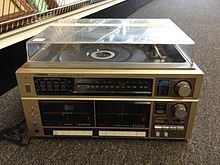Type Corporation Website FISHER | ||
 | ||
Products Audio-Visual and communication equipment, Hi-fi equipment, Home appliances Motto Bringing High Definition to Audio Founded 1945, New York, United States | ||
Fisher electronics magazine ad archives
Fisher Electronics was a United States-based subsidiary company of Japanese electronics conglomerate Sanyo specialising in the field of hi-fi electronics.
Contents
- Fisher electronics magazine ad archives
- Fisher electronics none are so fond of vaz secrets as those who do not mean to keep them
- History
- The Fisher
- Other consumer products
- References
Fisher electronics none are so fond of vaz secrets as those who do not mean to keep them
History
The company was originally formed in 1937 by Avery Fisher in New York before being sold to the Emerson Electric Company for US$31 million in 1969. It was subsequently sold by Emerson Electric to Sanyo Electric of Japan in 1975, where it remained until 2010 when Sanyo was purchased by Panasonic. But the Fisher brand was phased out owing to the termination of Sanyo by Panasonic in 2012. Avery Fisher remained as a consultant for Emerson and Sanyo.
Fisher is generally known to be the first company to introduce separate audio components. Originally, hi-fi systems were integrated all into one chassis.
The Fisher
The Fisher was the brand name for high-end, high quality hi-fi electronic equipment manufactured in New York by The Fisher Radio Corp. during the "golden age" of the vacuum tube, which was named after the company founder, Avery Fisher.
During this period, similar brands were H.H. Scott, Marantz, Harman Kardon, and McIntosh. Some of the early 1960s models were also available as kits. Fisher tube equipment is considered quite collectible today.
Fisher's first receiver was the model 500, a mono AM/FM receiver using two EL37 output tubes. It had a brass-plated face panel and an optional mahogany or "blonde" wooden case. This early mono receiver should not be confused with the later stereo tube receiver models, the 500B and 500C. These later receivers made in the early 1960s were stereo using push-pull 7591 output tubes. They were also sold with optional wood cabinets and had aluminum faceplates instead of the brass on the earlier 500 receiver.
Well-known models include (but are not limited to):
The Fisher was also used on Fisher's early US made solid-state equipment, such as the model 210 receiver.
Fisher FM tuners and receivers often used similar designs and components thus allowing parts to be swapped between various models. A good example is the FM stereo multiplex decoder module.
Fisher was the first to introduce stereo receivers with Four Channels. These innovations were brief and occurred in the Mid-1970's which some consider The Second Golden Age of High Fidelity. Like many new concepts of the time such as Beta Format and VHS, there were two competing four channel formats. One was CD-4 and the other was SQ. Neither was successful as the purist found separation from highly defined loudspeakers and low distortion receivers and amplifiers. At the time the concept of a sub-woofer was in its infancy. Now, it is common to see 5+1 systems which had their heritage in the "confrontation" of four-channel and stereo high fidelity coupled with a sub woofer.
Other consumer products
Under Sanyo ownership, Fisher also commercialized a range of consumer products including
In particular, the air conditioning business of Sanyo and Fisher brands was unified in 2000 under the Sanyo Electric Air Conditioning Co. Ltd. scheme, to end up eventually in 2011 with the buyout from Panasonic.
